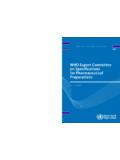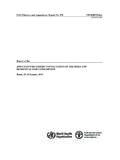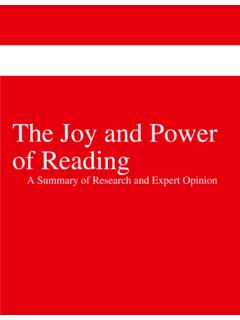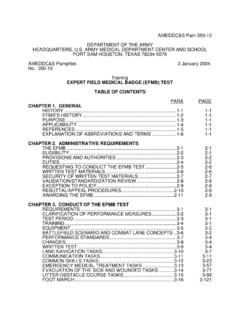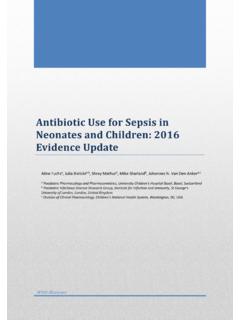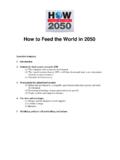Transcription of EGM Expert Paper Theng Leng Leng - United Nations
1 1 Promoting intergenerational understanding between the young and old: the case of Singapore leng leng Thang, National University of Singapore Introduction Ask a youth what comes to your mind when you think of the old and young generations, chances are the term generation gap will be one common association. There is little doubt that generational segregation has increasingly become a norm in today s modern industrialized societies. The social structuring of age has contributed to an extent the gap among generations. One important dimension of age segregation is institutional age segregation where different age groups are isolated from the socially constructed division according to chronological age, such as the channeling of the young into day care and schools and expecting seniors to live separately in age-homogenous retirement communities.
2 Among the various social institutions, the family is probably the only institution that is truly age integrated (Hagestad and Uhlenber, 2005, 2006), however, the advent of nuclear families, more instances of divorces, singlehood, migration and so forth have increasingly limited the capacity of the family to provide cross-age understanding and connections. In fact, we can no more assume that strong bonding will certainly exist between the generations even when three generations live under the same roof. With different pace of life and activities, it is common for different generations to live in so-called separate islands of activity even when they are living in the same household.
3 Grandparents who are alone the whole day may feel isolated in a three-generational household; even when their children and grandchildren are at home in the evening, they are likely to be tucked away in their own rooms facing their own TVs and computer screens. Age segregation has various undesirable consequences, besides producing ageism which leads to the discrimination of young people against the old, it also reinforces the negative stereotype of the young among the old. Further more, social support network within the family as well as society is expected to weaken when horizontal connections between the same age peers are not enriched and extended by vertical connections across different ages.
4 As the intergenerational equity conflicts of the 1980s and the 1990s in the have shown, generation gap threatens social cohesion and will lead to tensions emphasizing competition of the generations for limited resources and the fear of an intergenerational war. The gulf between the generations fear deepening with changing social patterns and demographic trends and imply an urgent need for deliberate program and policy efforts to address the disengagements of the generations. How then, can intergenerational understanding be promoted to bridge the generation gap and enhance generational re-engagement in the family, community and the wider society?
5 The concept of intergenerational programs as deliberate attempts to connect the old and young 2 through program activities have shown to produce desirable outcome and increasingly recognized as an effective tool to close the generation gap (Newman , 1997). This Paper will discuss issues of intergenerational understanding and dialogue through the intergenerational initiatives with a focus on Singapore - an economically advanced city-state located in Southeast Asia confronted with rapid demographic transition and significant changes in household and social patterns.
6 With a family-centric policy, the national and community efforts to promote intergenerational connection in Singapore show relevance for the discussion of policies and practice in the area. In the following, I will begin with a brief discussion on changing family trends in Singapore before moving on to delineate the development of efforts to promote intergenerational understanding on the national level. Then a discussion of some of the intergenerational initiatives from the educational institutions will follow before the Paper concludes with policy recommendations for mutual understanding across generations on the local and national levels.
7 Changing family trends in Singapore As a country with strong emphasis on the family as the basic building block of society and the family as the first line of care and support for its members, families in Singapore remain strong, with 96% of those surveyed agreeing that they have a closely-knitted familyi. However, demographic and social changes are affecting family trends in Singapore. Although Singapore has expanded its population rapidly to 5 million in 2010, up from 4 million in 2000, much of the growth has occurred due to migration influx.
8 Like most advanced countries and economically advancing Nations , Singapore is also faced with aging demography attributed by an increase in longevity and a drastic fall in birth rate. Singapore is one of the countries with the fastest rate of aging, while the proportion of those 65 years and above reached 8 percent only in 1998, it is expected to increase to about 19 percent by 2030, recording a phenomenal growth rate of percent(DOS 2002). In 2010, as life expectancy has risen to a high of for female and 79 for male, birth rate has fallen to a new low of Delay in marriages and a rise in singlehood continue to be two important factors affecting birth rate; with the percentage of Singaporeans remaining single between 40-44 years old rising from 11% in 1990 to 17% in 2005 for men and 10% to 15% for women.
9 The changing demographic trends have intersected with changes in household and social patterns to affect family trends. With the norm in nuclear households, the number of members per household has shrunk from in 1980 to in 2010. An increasing proportion of households have members who are at least 65 years old, a rise from 21% in 2000 to 24% in 2010; and households comprising only of older members have increased from to in the same periodiii The trends in household size and composition imply that although the older generation has increased in number over the years, less younger members are living together with their grandparents, coupled with institutional segregation, the young are connecting less with the older population.
10 3 National efforts to promote intergenerational bonding With the family as the only truly integrated social institution, it is inevitable for efforts to promote intergenerational bonding to bring focus on intergenerational relations within the familial context. In Singapore, the setting up of the taskforce to promote grandparenting and intergenerational bonding in July 2002 by the Singapore Ministry of Community Development (now expanded as the Ministry of Community Development, Youth and Sports) could be regarded as the starting point of state effort to promote intergenerational initiatives in Singapore.










